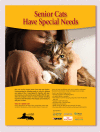2021 AAFP Feline Senior Care Guidelines
- PMID: 34167339
- PMCID: PMC10812122
- DOI: 10.1177/1098612X211021538
2021 AAFP Feline Senior Care Guidelines
Erratum in
-
2021 AAFP Feline Senior Care Guidelines.J Feline Med Surg. 2021 Oct;23(10):NP4. doi: 10.1177/1098612X211040404. Epub 2021 Aug 11. J Feline Med Surg. 2021. PMID: 34378451 Free PMC article. No abstract available.
Abstract
The '2021 AAFP Feline Senior Care Guidelines' are authored by a Task Force of experts in feline clinical medicine and serve as an update and extension of those published in 2009. They emphasize the individual patient evaluation and the process of aging, with references to other feline practice guidelines for a more complete discussion of specific diseases. Focusing on each cat encourages and empowers the owner to become a part of the cat's care every step of the way. A comprehensive discussion during the physical examination and history taking allows for tailoring the approach to both the cat and the family involved in the care. Videos and analysis of serial historical measurements are brought into the assessment of each patient. These Guidelines introduce the emerging concept of frailty, with a description and methods of its incorporation into the senior cat assessment. Minimum database diagnostics are discussed, along with recommendations for additional investigative considerations. For example, blood pressure assessment is included as a minimum diagnostic procedure in both apparently healthy and ill cats. Cats age at a much faster rate than humans, so practical timelines for testing frequency are included and suggest an increased frequency of diagnostics with advancing age. The importance of nutrition, as well as senior cat nutritional needs and deficiencies, is considered. Pain is highlighted as its own syndrome, with an emphasis on consideration in every senior cat. The Task Force discusses anesthesia, along with strategies to allow aging cats to be safely anesthetized well into their senior years. The medical concept of quality of life is addressed with the latest information available in veterinary medicine. This includes end of life considerations like palliative and hospice care, as well as recommendations on the establishment of 'budgets of care', which greatly influence what can be done for the individual cat. Acknowledgement is given that each cat owner will be different in this regard; and establishing what is reasonable and practical for the individual owner is important. A discussion on euthanasia offers some recommendations to help the owner make a decision that reflects the best interests of the individual cat.
Keywords: Senior; anesthesia; blood pressure; budgets of care; cancer; chronic kidney disease; cognitive dysfunction syndrome; comorbidities; degenerative joint disease; dental disease; diabetes mellitus; end of life; euthanasia; frailty; gastrointestinal disease; hospice care; hypertension; hyperthyroidism; osteoarthritis; pain; palliative care; quality of life; sarcopenia.
Conflict of interest statement
Hazel Carney is a speaker for Royal Canin. Jessica Quimby is a key opinion leader for Boehringer Ingelheim Animal Health USA, Inc., Dechra, Elanco, Gallant Health Care, Heska, Hill’s Pet Nutrition, Inc., IDEXX Laboratories, Inc., Kindred Biosciences, Inc., Purina ProPlan Veterinary Diets, Royal Canin, and Zoetis Petcare. Sheilah Robertson acts variously as a key opinion leader, speaker and consultant for Elanco, Zoetis Petcare, and Jurox. The other members of the Task Force have no conflicts of interest to declare.
Figures



























Comment in
-
Senior care: setting the stage for optimal feline aging.J Feline Med Surg. 2021 Jul;23(7):611. doi: 10.1177/1098612X211021537. J Feline Med Surg. 2021. PMID: 34167337 Free PMC article. No abstract available.
References
Publication types
MeSH terms
LinkOut - more resources
Full Text Sources
Medical
Miscellaneous

